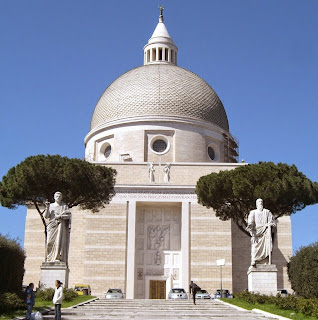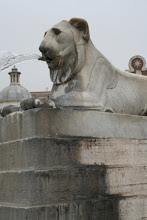Very few tourists go to EUR, Mussolini’s Esposizione Universale Roma although they all see it
from the airport. It’s impossible to
miss the giant dome of the Basilica of Peter and Paul, and the Palazzo della Civiltà
Romana , the “square colosseum” designed and built in the 1940’s to celebrate
20 years of fascist rule.
Mussolini had a great admiration for ancient Rome (as much
as he razed some of it to build his grand roads) and the architecture of the
public buildings were built along the lines of such monuments as Trajan’s
Markets and the Forum. Materials like
travertine, tufa and marble were used in a take-no-prisoners clean aesthetic,
and the public buildings, arranged within a grid with central axis, stand out
in stark relief.
There are no piazzas, no chaos and none of the crowding
usually associated with Rome. It’s
largely a business district, with head offices for a lot of national and multi-national
companies based here.
So why go there? Because
there are three museums at EUR, and they all house incredible treasures. One, the Civiltà Romana, displays the scale model of ancient Rome, familiar to anyone who has seen a travel guide to
Rome. The Forma Urbis, or the Severan
Marble Map of Rome from 200 AD is also held here. Unfortunately the Civilta Romana remains
closed due to lack of funds.
Another, the Prehistoric
Ethnographic Museum houses artefacts and information on human settlements from
the Iron Age, including tombs from the Bronze age uncovered close by at Tolfa,
a little to the North.
The museum I
visited yesterday, along with my italian conversation buddy, was the Museum of
Early Middle Ages, which houses some beautiful finds from the settlements of
the Lungobards in Italy. Armour,
jewellery and weaponry in precious metals and stone dazzles. But the greatest surprise of all is housed
here – an entire frescoed room in opus
sectile, a style of marble mosaic, uncovered from Ostia Antica in 1960 and
reassembled here at the museum. The
room, part of a seaside villa, dates from 385 AD. No-one knows why this room
remained uncompleted (the stones were laid out in special formation, ready to
be fixed to the walls and ceiling) although there are theories. Was there an earthquake? Was there a pagan revolt? Miraculously the completed walls collapsed in
on themselves, sealing the mosaics in several layers. Within the reconstructed room you can see
lions and tigers hunting prey and the figure of a man, with halo, believed
alternately to be Christ, or a philosopher.
The mosaics are of the highest quality and marbles are lovely.
.jpg) |
| The mosaic room housed at the museum |
.jpg) |
| One side of the mosaic, tigers hunting. The "Christ" figure is on the lower panel |

.jpg)


No comments:
Post a Comment